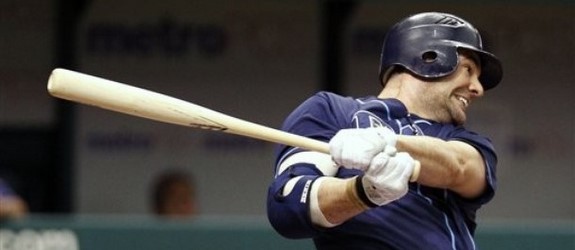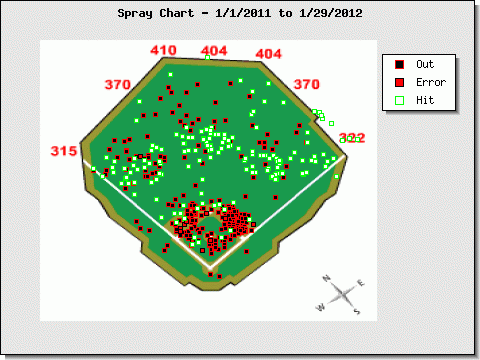We’ve spent a good portion of the last two weeks writing about potential DH options for the 2012 Yankees, and most of them have been older players trying to hang on for one last chance at a ring or for love of the game. Or money, that’s important too. One player we haven’t talked about yet is a 28-year-old free agent in the prime of his career, the same guy who led all currently unsigned free agents in OBP (.378), wOBA (.351), and fWAR (2.8) in 2011. It’s not particularly close either. That player is Casey Kotchman. So why haven’t we talk about him yet? It’s simple: I don’t think he can do it again.

Once upon a time, Kotchman was supposed to be a star. Baseball America considered him the sixth best prospect in the game before the 2005 season, saying he “projects to hit at least 20-25 homers annually” and “is a future Gold Glover” in their Angels Top 10 List (subs. req’d). Needless to say, it never worked out like that. Kotchman hit a decent .274/.337/.426 (99 OPS+) with 31 total homers in 1,265 plate appearances for the Halos before being traded to the Braves for Mark Teixeira in 2008. He spend time in Atlanta, Boston, and Seattle before resurfacing with the Rays in 2011.
Called up when Manny Ramirez abruptly retired in mid-April, Kotchman was a .259/.326/.392 career hitter (91 OPS) in over 2,300 plate appearances coming into the year. He went on to hit .306/.378/.422 in 563 plate appearances for Tampa Bay last season, a 128 OPS+ and by far the best single season of his career. The results were much better, but as you can see in the chart below, his underlying performance wasn’t all that different…
| PA | BB% | K% | HR%* | ISO | LD% | GB% | FB% | IFFB%** | |
|---|---|---|---|---|---|---|---|---|---|
| 2004-2010 | 2,328 | 8.2% | 9.6% | 2.6% | 0.133 | 17.6% | 52.7% | 29.7% | 3.7% |
| 2011 | 563 | 8.5% | 11.7% | 2.3% | 0.116 | 18.3% | 55.8% | 25.9% | 3.0% |
* HR% is homers per plate appearances with contact (so removing walks, strikeouts, etc.).
** IFFB% is true infield fly ball rate, so FB% x IFFB% on FanGraphs.
His walk rate is essentially identical, a 2.1% more strikeouts is nothing (an extra dozen whiffs per 600 plate appearances. His batted ball profile is relatively unchanged, give or take a few percent that can easily be attributed to bias and human error during the data collection process. Here’s his batting ball data in graphical form, with green being ground balls, red being line drives, and blue being plain old fly balls…

Kotchman has become more of a ground ball hitter over the last three or four years, but nothing insane. Despite the similar batted ball profiles, he enjoyed a .335 BABIP last season compared to .277 for the first six-plus years of his career. A 58-point difference is not insignificant, though it’s worth noting that xBABIP (expected BABIP based on batted ball profile) says he should have had a .318 BABIP (using Chris Dutton’s Quick Calculator). The 0.017 difference between BABIP and xBABIP means he lucked into about ten extra hits over the course of his 563 plate appearances. Assuming they were all singles, his expected batting line in 2011 was .286/.361/.402. A .763 OPS would have been a 104 OPS+, so just a touch above league average.
Now there’s nothing wrong with being a bit better than average, it’s better than what the Yankees got out of their DHs last season (99 OPS+). It is fair to question whether or not Kotchman can do it again though, especially since the first six-plus of his career were pretty awful. He’s a slow ground ball hitter, so it’s easy to be skeptical of his ability to continue to turn those ground balls into base hits. Kotchman never developed the power Baseball America thought he would, and although Yankee Stadium figures to help him out a bit in that department, let’s not act like the short porch is a cure-all. He wasn’t exactly Mr. Deep Fly Ball To Right last year (via Texas Leaguers)…
Remember, the dots are where the ball was fielded, not where it landed.
Kotchman grounded into a double play in 15% of his opportunities last year (league average was 10%), one of the highest marks in the game. He only took the extra base 35% of the time as well (league average was 41%), so we’re talking about a guy that needs three singles to score from first. In fairness, that applies to most DH-types. His glovework — while very good — is a non-factor at DH, though I do appreciate a DH that can take the field once in a while and not embarrass himself. Essentially, we’re talking about a singles hitter — a singles hitter with contact skills and enough discipline to get on-base at a respectable clip — and the proverbial “one good year.”
You can definitely make the argument that Kotchman will continue to get better given his age, or at least that the odds of him improving are greater than the odds of Johnny Damon, Raul Ibanez, et al. not declining. I have to think that he’s looking to parlay his strong season into as much a) money, and b) opportunity as possible. Being a platoon DH and seventh-hole hitter for the Yankees might not be what he wants, since he’s at an age where proving he’s a legitimate starting first baseman in the big leagues can turn into a handsome payday. Kotchman may very well be the best man for the job, but I’m not convinced of it. There’s just too much evidence suggesting last year’s results are not indicative of his true talent.

Leave a Reply
You must be logged in to post a comment.